Yes, you read it correctly. In this post I'll kick the tires with and walk you through how you can use the world's first managed k3s service. k3s is a light-weight distribution of Kubernetes re-packaged by Darren Shepherd, Chief Architect at Rancher Labs.
I'll introduce you to Civo and how the idea came about. Then I will show you how to use the platform to setup a 5-node cluster with OpenFaaS, cert-manager, metrics-server, Minio, and persistent storage, all within a few minutes. At the end of the post, I'll wrap things up with a quick summary and show you how to get involved.
Disclosure: Civo is a client of OpenFaaS Ltd
How did this all start?
It all started when Civo Cloud based out of Stevenage in the UK asked me to help them think through what a managed Functions and Kubernetes service would look like and what they should prioritize first. I advised the team to build their Kubernetes service first, and that a Functions platform like OpenFaaS or OpenWhisk could be hosted on it at a later date.
The team had been using Kubernetes to run their own platform for several months and had previously drawn-up plans to build a managed offering with the classic HA control-plane and hidden master. Whilst deep in discussion about IP subnets and networking drivers, their CTO Andy Jeffries asked a question:
"Could we just use k3s?"
That's where it all started and since then I've worked with Civo as a consultant and Cloud Native coach through OpenFaaS Ltd. I gave regular feedback and advice on the developer experience and design. I've been impressed by the speed at which the team has delivered a functioning product with a simple developer-experience. The team are now seeking input from the community and have launched an early access program.
Kicking the tires
Civo are giving early access to a limited number of developers through the #kube100 program. Participants of #kube100 will get a swag shipment from Civo HQ and enough credit to run a 3-node cluster for free for the duration of the program.
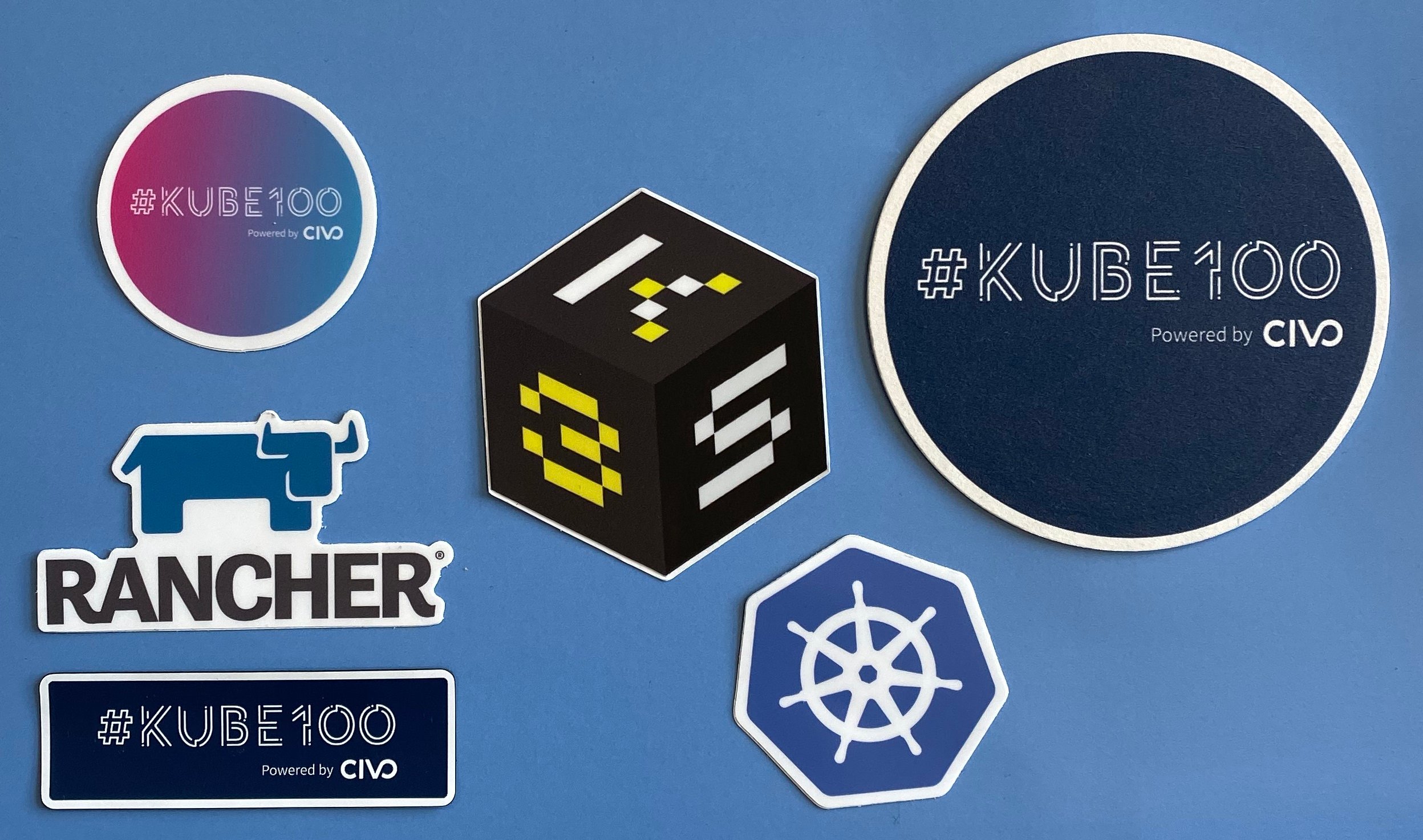
- Sign up for #KUBE100 and receive free credits to get started
Create the cluster
There are three ways to create a cluster:
- The "Kubernetes" tab on Civo.com
- The Civo CLI (written in Ruby, available as a gem)
- Civo.com REST API
I'll show you how 1) and 2) work in detail.
Let's start with 1) - the UI.

I was greeted with a friendly welcome page
Click Launch my first cluster.
On this page you first select how many nodes you'd like, what to call the cluster and how much memory/CPU you'd like to have for each node.
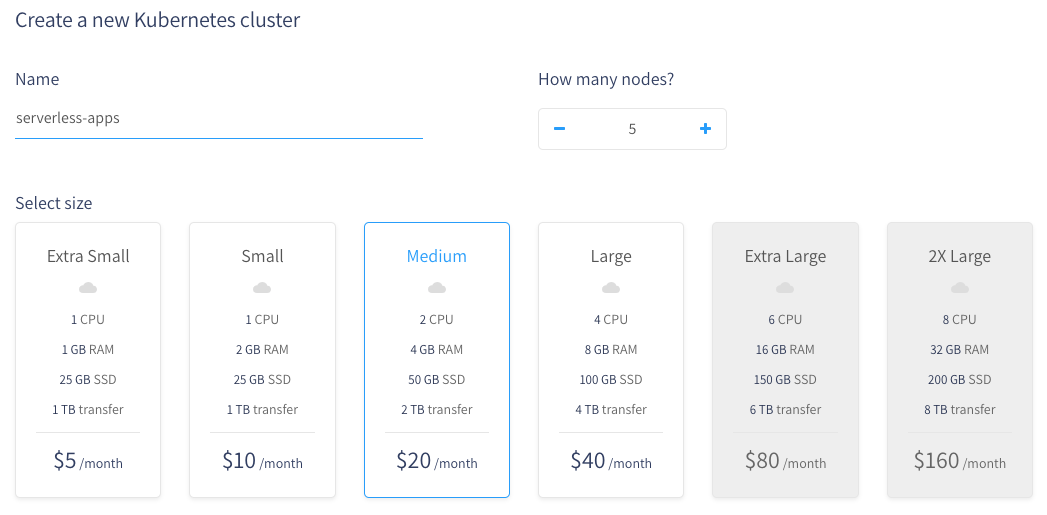
The cluster can be scaled at any time to add or remove nodes.
You can now select which applications you'd like to have pre-installed from the Civo Marketplace. Each application is added through pull-request on GitHub.com in the k3s-marketplace repo.

Your cluster will now take between 1-2 minutes to provision and then you can get hold of your KUBECONFIG and start deploying your code.

Whilst the cluster is spinning up, I wanted to mention the third-way to create and managed clusteres: the Civo REST API. You can find API documentation with examples showing curl, Node.js and Ruby. As a #kube100 participant, you can access this via https://www.civo.com/api/kubernetes.
The first version of the API includes:
- Create a cluster
- List clusters
- Get a cluster
- Update a cluster (can be used to scale nodes)
- List marketplace applications
- Delete a cluster
- Recycle a node
The Marketplace for "applications"
Before writing this post I submitted PRs to add: cert-manager, openfaas, and metrics-server. I found the experience relatively straight-forward, it involved writing a YAML file and a shell script.
Here's what I wrote for OpenFaaS:
name: OpenFaaS
version: 0.17.0
dependencies:
- Helm
maintainer: "@openfaasltd"
description: "OpenFaaS (Functions as a Service) is a framework for building serverless functions with Docker and Kubernetes which has first class support for metrics."
url: https://www.openfaas.com/
category: architecture
configuration:
GATEWAY_PASSWORD:
label: "Gateway password"
value: "CIVO:ALPHANUMERIC(20)"
Civo added a templating language which allows passwords and other configuration to be generated at deployment time.
#!/bin/bash
kubectl apply -f https://raw.githubusercontent.com/openfaas/faas-netes/master/namespaces.yml
helm repo add openfaas https://openfaas.github.io/faas-netes/
kubectl -n openfaas create secret generic basic-auth \
--from-literal=basic-auth-user=admin \
--from-literal=basic-auth-password="$GATEWAY_PASSWORD"
helm repo update \
&& helm upgrade openfaas --install openfaas/openfaas \
--namespace openfaas \
--set basic_auth=true \
--set functionNamespace=openfaas-fn
The script is almost a 1:1 reflection of the OpenFaaS helm chart instructions, which will make maintenance relatively easy.
You can also supply a markdown file which is displayed to users after they have installed your application.
The cluster status
The cluster status is shown whilst it is being built and then the same page shows the applications added and how to access any passwords or generated configuration.

Each node gets its own IPv4 IP-address and can be accessed via a DNS record which has round-robin configuration for each IP.
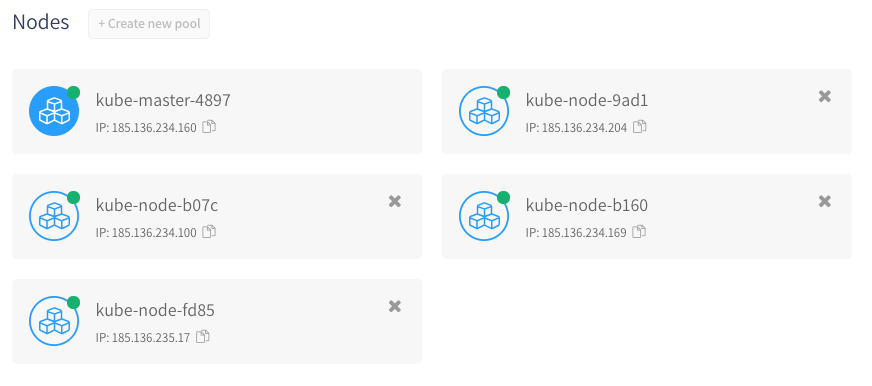
nslookup 228e6d0a-53ba-4d5c-b237-0bc7271e613e.k8s.civo.com
Server: 1.1.1.1
Address: 1.1.1.1#53
Non-authoritative answer:
Name: 228e6d0a-53ba-4d5c-b237-0bc7271e613e.k8s.civo.com
Address: 185.136.234.160
Name: 228e6d0a-53ba-4d5c-b237-0bc7271e613e.k8s.civo.com
Address: 185.136.234.169
Name: 228e6d0a-53ba-4d5c-b237-0bc7271e613e.k8s.civo.com
Address: 185.136.234.204
Name: 228e6d0a-53ba-4d5c-b237-0bc7271e613e.k8s.civo.com
Address: 185.136.235.17
Name: 228e6d0a-53ba-4d5c-b237-0bc7271e613e.k8s.civo.com
Address: 185.136.234.100
This is especially useful because there is currently no Kubernetes LoadBalancer integration available for Civo yet.
Traefik comes pre-installed as your IngressController, so you can create a CNAME for the "DNS Name" to match your own domain name such as openfaas.on-k3s.dev
Applications status
We can also view the status of the applications which we've installed and view the post installation guide.
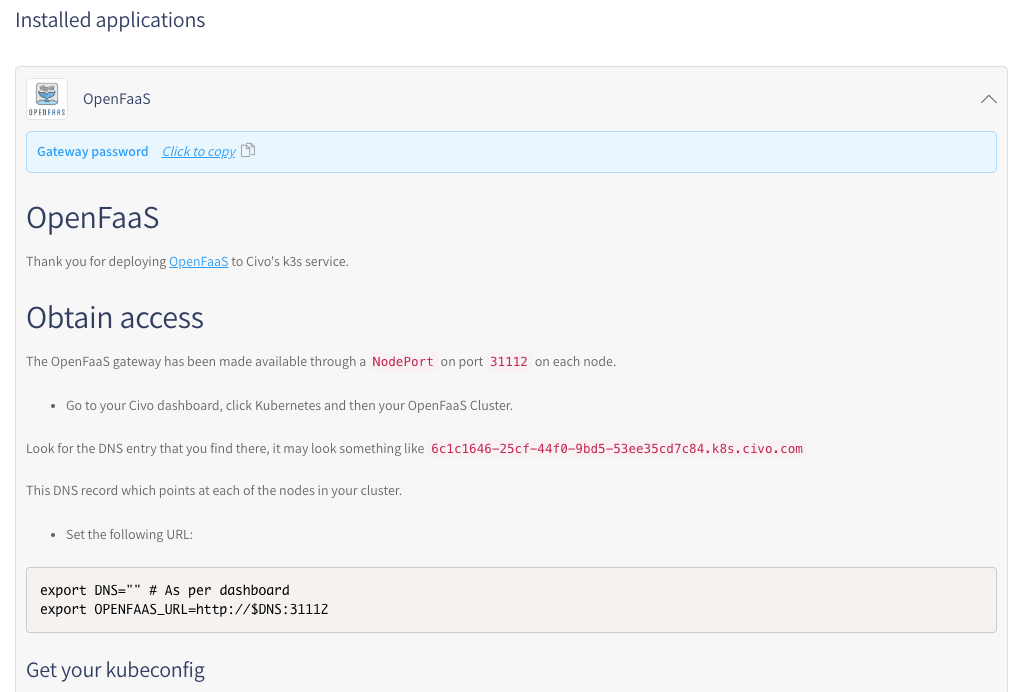
I loved the way that the login password for OpenFaaS was only one click away at all times. I can just log into the dashboard and click on the application to copy it to my clipboard.
Any values which are templated at installation time will appear pinned here. I don't know if you've ever had to go searching for a command to retrieve your Postgres password from a helm chart? I have. This makes for a refreshing developer experience.
Remember that I also installed Minio?
Well you can get the access and secret key in exactly the same way 👇

Get to kubectl
With every managed Kubernetes service there are normally two ways to get access a KUBECONFIG file and kubectl.
- Download from the UI (a single click), then run
export KUBECONFIG=SOME_PATH - Download via a CLI command
Civo's k3s is no different. You can download the KUBECONFIG file as soon as the cluster is ready.
You can install the Civo CLI with Ruby via sudo gem install civo civo_cli, then follow the instructions to add an API key.
For the CLI there are a set of commands which the team added for Kubernetes:
# List clusters
civo kubernetes ls
...
serverless-apps
...
# Save and merge a kubeconfig to ~/.kube/config
civo kubernetes config --save CLUSTER_NAME
Merged config into ~/.kube/config
Note: the context does not change by default, so use
kubectl config set-contextto do that.
There are also we useful aliases: civo k3s and civo k8s.
A feature I really liked was being able to type in civo k8s create with no parameters, node sizes or even a name, and to be able to get a working cluster within a minute or two.
See it in action here:
To set up a cluster with OpenFaaS or some other applications, just add --applications to civo k8s create.
Try an application - OpenFaaS
Since we installed OpenFaaS earlier as an application, all I have to do is to copy the gateway password and then find the link for the gateway.
DNS Name: 228e6d0a-53ba-4d5c-b237-0bc7271e613e.k8s.civo.com
So it will be the following:
export DNS=228e6d0a-53ba-4d5c-b237-0bc7271e613e.k8s.civo.com
export NODE_PORT=31112
export OPENFAAS_URL=http://$DNS:$NODE_PORT
echo $OPENFAAS_URL
http://228e6d0a-53ba-4d5c-b237-0bc7271e613e.k8s.civo.com:31112

I can also log into OpenFaaS using the faas-cli:
cat | faas-cli login --password-stdin
# Now enter the password, followed by Control+D
Calling the OpenFaaS server to validate the credentials...
WARNING! Communication is not secure, please consider using HTTPS. Letsencrypt.org offers free SSL/TLS certificates.
credentials saved for admin http://228e6d0a-53ba-4d5c-b237-0bc7271e613e.k8s.civo.com:31112
Note the warning on TLS, by default the OpenFaaS chart comes without TLS enabled.
You can add SSL/TLS through an IngressController and cert-manager using this guide for SSL.
Now you can deploy a Function from the OpenFaaS Function Store:

You can pick from a mixture of samples, machine learning models, and utilities. I've deployed the "haveibeenpwned" function
The haveibeenpwned function finds out whether a password was used in a breach. The code is available here and is written with the Go template.
Let's try the word kubernetes:

haveibeenpwned showed us that it was only used 6 times. Let's try the same with the command line and password.
curl --data "password" http://228e6d0a-53ba-4d5c-b237-0bc7271e613e.k8s.civo.com:31112/function/haveibeenpwned
{"found":3730471}
# or use the CLI
echo password | faas-cli invoke
Can you believe that so many people actually use password for their login credentials?!
If you'd like to learn how to build microservices, web-pages, and functions with OpenFaaS, then try the hands-on OpenFaaS workshop.
Try an application - metrics-server
The post install guide that I wrote for the metrics-server application shows how to test and make use of kubectl to interrogate node and Pod usage across your cluster.

Node usage:
kubectl top node
NAME CPU(cores) CPU% MEMORY(bytes) MEMORY%
kube-master-4897 133m 6% 849Mi 21%
kube-node-9ad1 62m 3% 563Mi 14%
kube-node-b07c 74m 3% 621Mi 15%
kube-node-b160 87m 4% 519Mi 13%
kube-node-fd85 81m 4% 550Mi 13%
Pod usage:
kubectl top pod --all-namespaces
NAMESPACE NAME CPU(cores) MEMORY(bytes)
cert-manager cert-manager-79d7495f47-vd9zd 3m 10Mi
cert-manager cert-manager-cainjector-6f868ccdf6-fqsp4 3m 16Mi
cert-manager cert-manager-webhook-5896b5fb5c-f9999 1m 7Mi
kube-system coredns-b7464766c-mjm9j 3m 8Mi
kube-system metrics-server-7f7ffff45b-94rbj 2m 15Mi
kube-system svclb-traefik-972t2 0m 1Mi
kube-system svclb-traefik-c957l 0m 1Mi
kube-system svclb-traefik-g6rt6 0m 1Mi
kube-system svclb-traefik-lklt8 0m 1Mi
kube-system svclb-traefik-qhgs8 0m 1Mi
kube-system tiller-deploy-7f4d76c4b6-6wl4b 1m 9Mi
kube-system traefik-5c79b789c5-hzw22 4m 17Mi
longhorn-system csi-attacher-684954f579-9kvn2 1m 4Mi
longhorn-system csi-attacher-684954f579-vldq6 1m 4Mi
longhorn-system csi-attacher-684954f579-zjz5l 2m 7Mi
longhorn-system csi-provisioner-589c467bb6-5wc7z 3m 7Mi
longhorn-system csi-provisioner-589c467bb6-895n2 1m 4Mi
longhorn-system csi-provisioner-589c467bb6-94crn 1m 5Mi
longhorn-system engine-image-ei-9bea8a9c-8pdkf 2m 10Mi
longhorn-system engine-image-ei-9bea8a9c-9dwmr 2m 1Mi
longhorn-system engine-image-ei-9bea8a9c-jqzjg 2m 1Mi
longhorn-system engine-image-ei-9bea8a9c-snjcv 2m 1Mi
longhorn-system engine-image-ei-9bea8a9c-xn69h 2m 1Mi
longhorn-system longhorn-csi-plugin-9ph88 1m 9Mi
longhorn-system longhorn-csi-plugin-b4h28 1m 9Mi
longhorn-system longhorn-csi-plugin-x8xqv 1m 9Mi
longhorn-system longhorn-csi-plugin-xzxfg 1m 9Mi
longhorn-system longhorn-csi-plugin-z5q7t 1m 8Mi
longhorn-system longhorn-driver-deployer-5df9b9c4b-6zcnx 0m 7Mi
longhorn-system longhorn-manager-7rlbl 5m 21Mi
longhorn-system longhorn-manager-96lqh 3m 21Mi
longhorn-system longhorn-manager-blxxw 6m 21Mi
longhorn-system longhorn-manager-x25gr 7m 22Mi
longhorn-system longhorn-manager-z6qcb 5m 21Mi
longhorn-system longhorn-ui-58c8f5d577-nqml8 0m 2Mi
openfaas alertmanager-78cb768565-c8mql 1m 7Mi
openfaas basic-auth-plugin-85994747dd-5zk5v 1m 6Mi
openfaas faas-idler-6568bb4c9b-ssx4c 1m 4Mi
openfaas gateway-5b68979d6b-rkbc5 2m 17Mi
openfaas nats-d4c9d8d95-qg6h2 1m 4Mi
openfaas prometheus-7b4598df45-r6p7t 3m 30Mi
openfaas queue-worker-56b64d6848-wfql6 1m 1Mi
openfaas-fn haveibeenpwned-68b798f9c9-959tm 1m 4Mi
The majority of the workloads we can see were crearted by Longhorn. Rancher's Longhorn project adds PersistentVolume capabilities to k3s.
Can I get TLS for that?
I would like to add TLS to my OpenFaaS installation, so I'm going to create an Ingress record with annotations that cert-manager will respond to and a TLS issuer for the ACME HTTP01 challenge.
ingress.yaml
apiVersion: extensions/v1beta1
kind: Ingress
metadata:
name: openfaas-gateway
namespace: openfaas
annotations:
certmanager.k8s.io/acme-challenge-type: http01
certmanager.k8s.io/issuer: letsencrypt-prod
kubernetes.io/ingress.class: traefik
spec:
rules:
- host: gw.openfaas.on-k3s.dev
http:
paths:
- backend:
serviceName: gateway
servicePort: 8080
path: /
tls:
- hosts:
- gw.openfaas.on-k3s.dev
secretName: gw-openfaas-on-k3s-dev-tls-cert
issuer.yaml
apiVersion: certmanager.k8s.io/v1alpha1
kind: Issuer
metadata:
name: letsencrypt-prod
namespace: openfaas
spec:
acme:
email: your-email@domain.com
http01: {}
privateKeySecretRef:
key: ""
name: letsencrypt-prod
server: https://acme-v02.api.letsencrypt.org/directory
I then used kubectl apply -f to create both files and created a DNS CNAME to the record found in the Civo dashboard earlier.
This is what the DNS config looks like with Google Domains:

We can now log in with TLS enabled and have end-to-end encryption for our functions and micro-services deployed on OpenFaaS.
export OPENFAAS_URL=https://gw.openfaas.on-k3s.dev
echo $OPENFAAS_URL
https://gw.openfaas.on-k3s.dev
cat | faas-cli login --password-stdin
# Now enter the password, followed by Control+D
Calling the OpenFaaS server to validate the credentials...
credentials saved for admin https://gw.openfaas.on-k3s.dev
Now let's list our endpoints:
faas-cli list -v
Function Image Invocations Replicas
haveibeenpwned functions/haveibeenpwned:0.13.0 2 1
Notice that the insecure warning has now disappeared, and we can now use OpenFaaS with TLS encryption between our clients and our cluster.
What about scaling?
Civo k3s clusters can be resized at any time, and providing there is capacity, then your new workloads will be rescheduled in the cluster. The kubectl top node/pod command can help you estimate how densely you can pack the cluster.
Here's how much the cluster will cost me if I resize down to 3 nodes, instead of 5.
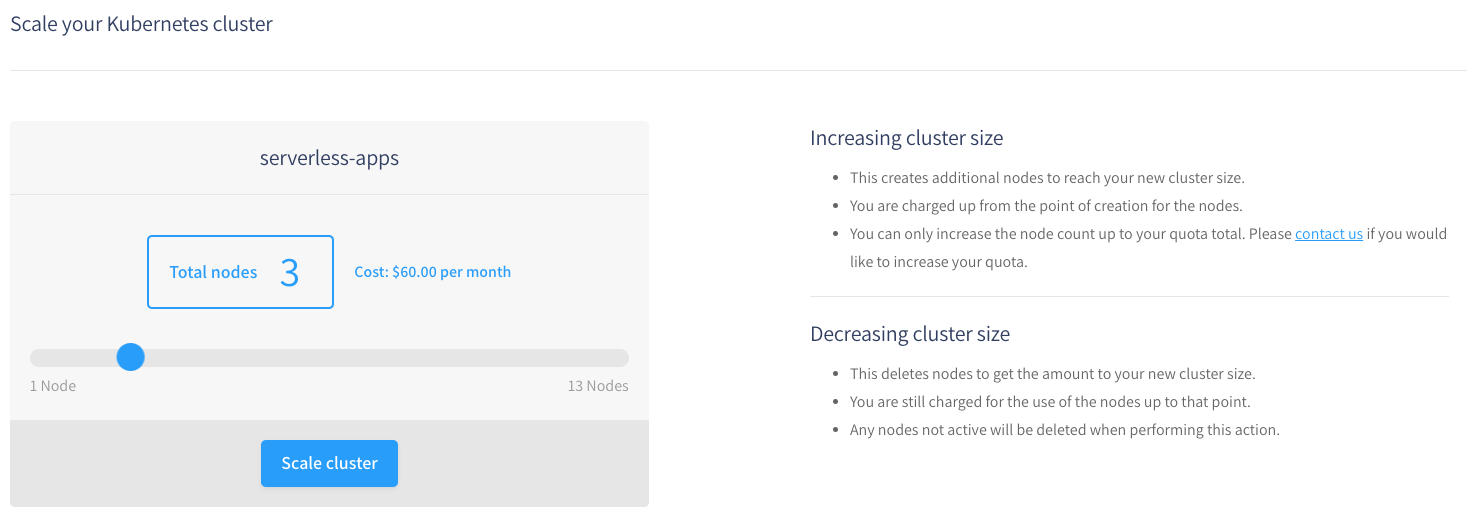
Right-sizing can be hard and auto-scaling groups or the Kubernetes Cluster auto-scaler can help here. At time of writing Civo is not supported, but this may be subject to change. I would encourage Civo to add support.
What I do like is that Civo go to lengths to help the user and to explain what each screen does.
You can create multiple clusters and view them on the overview page. For development, you can even create a cluster with a single server node.

Wrapping up
The Civo team are pioneering the world's first k3s service and seeking feedback from potential users and customers to shape it and add the remaining features to make it ready for development teams.
- The marketplace means that maintainers can package applications with ease
- The attention to detail and design of the UI and CLI bring a intuitive experience
- k3s makes for an accessible and light-weight Kubernetes experience
This is probably the easiest way to get OpenFaaS up and running on Kubernetes to date and adding TLS with cert-manager wasn't much harder either.
This Hacker News post on k3s shows that developers are very excited about any efforts we can make as an industry to level the barrier to entry for Kubernetes. I think that Civo's work represents a significant move forward in this area.
This post shared my first impressions with you today, but I've been leaning on my sense of developer experience and my experience as a CNCF Ambassador to guide and direct the vision for the k3s service and marketplace.
Here are some items I'd like to see next:
- A new cloudprovider for Civo in the Cluster Autoscaler
- Support for
LoadBalancereither through the Civo LoadBalancer offering, or with the DNS Name populated there - HA master - the Rancher master node (called a server) is only running a single instance, this is fine for development, but a HA-mode as an option would be ideal
- Additional applications: a registry, Postgres, Redis, and SealedSecrets
- Support for multiple node pools of differing sizes
- Built-in support for PersistentVolumes and CSI without hosting Longhorn
Creating applications for the marketplace was straight-forward and a painless experience, the UI integration is the best I've seen so far. For General Availability (GA), the team will also need to think through the lifecycle problem of updating and removing applications which is not covered yet.
You may have your own wishlist of items, so in the spirit of being fair and impartial, I think that you should sign up for #kube100. Use my blog post as a guide or tour of the features, but test it out for yourself and make up your own mind. I know the team will be keen to hear your feedback on the new Slack workspace and via GitHub.
- Sign up for #KUBE100 and receive free credits to get started
Coming up next
In the next post I'll use OpenFaaS to build an example Cloud Native app by taking advantage of the applications in the Civo marketplace. Follow me on Twitter @alexellisuk so you don't miss it.
You may also like: